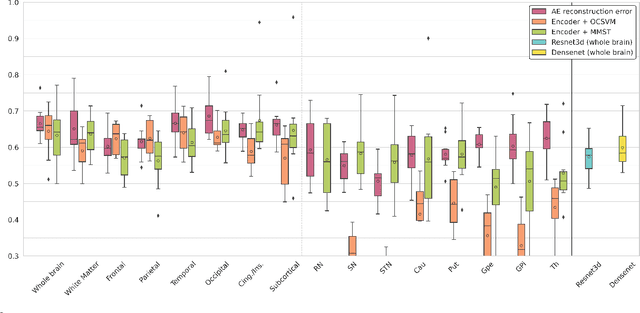Robin Trombetta
MYRIAD
Weakly supervised deep learning model with size constraint for prostate cancer detection in multiparametric MRI and generalization to unseen domains
Nov 04, 2024Abstract:Fully supervised deep models have shown promising performance for many medical segmentation tasks. Still, the deployment of these tools in clinics is limited by the very timeconsuming collection of manually expert-annotated data. Moreover, most of the state-ofthe-art models have been trained and validated on moderately homogeneous datasets. It is known that deep learning methods are often greatly degraded by domain or label shifts and are yet to be built in such a way as to be robust to unseen data or label distributions. In the clinical setting, this problematic is particularly relevant as the deployment institutions may have different scanners or acquisition protocols than those from which the data has been collected to train the model. In this work, we propose to address these two challenges on the detection of clinically significant prostate cancer (csPCa) from bi-parametric MRI. We evaluate the method proposed by (Kervadec et al., 2018), which introduces a size constaint loss to produce fine semantic cancer lesions segmentations from weak circle scribbles annotations. Performance of the model is based on two public (PI-CAI and Prostate158) and one private databases. First, we show that the model achieves on-par performance with strong fully supervised baseline models, both on in-distribution validation data and unseen test images. Second, we observe a performance decrease for both fully supervised and weakly supervised models when tested on unseen data domains. This confirms the crucial need for efficient domain adaptation methods if deep learning models are aimed to be deployed in a clinical environment. Finally, we show that ensemble predictions from multiple trainings increase generalization performance.
Anomaly detection in image or latent space of patch-based auto-encoders for industrial image analysis
Jul 04, 2023Abstract:We study several methods for detecting anomalies in color images, constructed on patch-based auto-encoders. Wecompare the performance of three types of methods based, first, on the error between the original image and its reconstruction,second, on the support estimation of the normal image distribution in the latent space, and third, on the error between the originalimage and a restored version of the reconstructed image. These methods are evaluated on the industrial image database MVTecADand compared to two competitive state-of-the-art methods.
One-Class SVM on siamese neural network latent space for Unsupervised Anomaly Detection on brain MRI White Matter Hyperintensities
Apr 17, 2023Abstract:Anomaly detection remains a challenging task in neuroimaging when little to no supervision is available and when lesions can be very small or with subtle contrast. Patch-based representation learning has shown powerful representation capacities when applied to industrial or medical imaging and outlier detection methods have been applied successfully to these images. In this work, we propose an unsupervised anomaly detection (UAD) method based on a latent space constructed by a siamese patch-based auto-encoder and perform the outlier detection with a One-Class SVM training paradigm tailored to the lesion detection task in multi-modality neuroimaging. We evaluate performances of this model on a public database, the White Matter Hyperintensities (WMH) challenge and show in par performance with the two best performing state-of-the-art methods reported so far.
Brain subtle anomaly detection based on auto-encoders latent space analysis : application to de novo parkinson patients
Feb 27, 2023

Abstract:Neural network-based anomaly detection remains challenging in clinical applications with little or no supervised information and subtle anomalies such as hardly visible brain lesions. Among unsupervised methods, patch-based auto-encoders with their efficient representation power provided by their latent space, have shown good results for visible lesion detection. However, the commonly used reconstruction error criterion may limit their performance when facing less obvious lesions. In this work, we design two alternative detection criteria. They are derived from multivariate analysis and can more directly capture information from latent space representations. Their performance compares favorably with two additional supervised learning methods, on a difficult de novo Parkinson Disease (PD) classification task.
 Add to Chrome
Add to Chrome Add to Firefox
Add to Firefox Add to Edge
Add to Edge